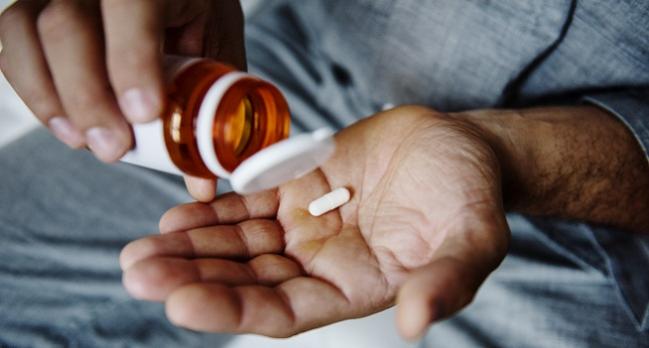Sacubitril/Valsartan Lowers Triglycerides in HFpEF: PARAGON-HF
Prospective studies are needed and mechanisms unclear, but the findings raise hopes for off-target benefits, says J. Emanuel Finet.

Compared with valsartan alone, the angiotensin receptor-neprilysin inhibitor (ARNI) sacubitril/valsartan (Entresto; Novartis) reduces triglycerides among patients with heart failure and preserved ejection fraction (HFpEF), according to results from a PARAGON-HF subanalysis. The effect was particularly marked in patients with higher triglycerides at baseline.
“Our research adds to the growing literature of the favorable metabolic effects of sacubitril/valsartan,” Senthil Selvaraj, MD (Hospital of the University of Pennsylvania, Philadelphia), who presented the findings today at the American College of Cardiology 2021 Scientific Session, told TCTMD in an email. “Sacubitril/valsartan may be part of the therapeutic armamentarium is reducing triglycerides as adjunct therapy. However, outcomes studies looking at related cardiovascular endpoints in high-risk populations are needed.”
PARAGON-HF, which was published in 2019, narrowly missed its primary endpoint of reducing the risk of hospitalization for heart failure or cardiovascular death with sacubitril/valsartan in a HFpEF population. Nonetheless, the US Food and Drug Administration approved the ARNI for use in HFpEF patients, stating that its benefits were “most clearly evident” in those with below-normal LVEF.
This analysis of 4,744 PARAGON-HF patients, simultaneously published in the Journal of the American Heart Association, shows that compared with valsartan alone, sacubitril/valsartan overall reduced triglycerides by 5% (-6.6% vs -3.5%; P < 0.001), increased HDL cholesterol by 2.6% (1.7% vs 3.4%; P < 0.001), and increased LDL cholesterol by 1.7% (0.4% vs 3.0%; P = 0.012). Triglycerides were reduced most strongly (-13%) by the study drug among the 15.7% of patients with elevated baseline levels (>200 mg/dL), corresponding to a median reduction of 30 mg/dL at 16 weeks.
Selvaraj said he was “most surprised by the magnitude of effect of triglyceride lowering in participants with elevated triglycerides.” By comparison, he pointed out, “the treatment effect was approximately a 20% reduction in triglycerides in REDUCE-IT” with icosapent ethyl (Vascepa; Amarin).
In a separate analysis done to help understand the pathways involved in the treatment effects, urinary cyclic guanosine monophosphate (cGMP) appeared to mediate the effects of sacubitril/valsartan on both triglycerides and HDL cholesterol, but not LDL cholesterol, Selvaraj explained. “Further, there were strong relationships between changes in urinary cGMP and changes in HDL cholesterol and triglycerides.” In addition, “there are a number of defined mechanisms by which natriuretic peptides affect triglycerides, including browning of fat and affecting activity of hormone sensitive lipase.”
“Our analyses provide insight into the therapeutic effect of sacubitril/valsartan on serum lipids and the relevance of the natriuretic peptide pathway to effects on triglycerides and HDL cholesterol,” the authors write. They point out that their findings are in line with a similar 2017 analysis of PARADIGM-HF data, published in the Lancet, which showed an increase in HDL cholesterol with sacubitril/valsartan compared with enalapril among patients with heart failure and reduced ejection fraction (HFrEF).
Selvaraj said that future research is needed “to define the role of sacubitril/valsartan in treatment of dyslipidemias prior to clinical implementation. There were small increases in HDL and LDL cholesterol also noted that may be relevant, and therefore adequately powered trials in this space among patients at elevated risk for atherosclerotic events would be needed.”
Prospective Study Needed Next
Commenting on the study for TCTMD, J. Emanuel Finet, MD (Cleveland Clinic, OH), said he was pleasantly surprised by these findings, much like how he felt seeing the 2017 PARADIGM-HF analysis in the Lancet. “We've already been hinting at these metabolic effects of the inhibition of neprilysin,” he said. “I think PARAGON is probably the best milieu to assess that just because of the higher incidence of metabolic syndrome in this population of HFpEF, compared to HFrEF, which you wouldn't really expect.”
Also, because valsartan alone was the comparator drug in PARAGON-HF, “you can actually isolate, in a way, the effects of neprilysin inhibition by sacubitril,” he added.
As for the mechanism at play, Finet said that cGMP “seems to be related to the direct effect of neprilysin in naturetic peptides, but it is hard to believe because I'm not really sure if the rise in LDL—that of course is not a desirable one—is really related to the same mechanism. So I think further studies need to be done to try to figure out really what are we talking about here.”
The next step to answer this question in full would be to do a prospective, randomized trial, and this analysis “by no means replaces” that, he said. “But this definitely contributes to the story of the metabolic and pleiotropic effects of neprilysin inhibition.”
Yael L. Maxwell is Senior Medical Journalist for TCTMD and Section Editor of TCTMD's Fellows Forum. She served as the inaugural…
Read Full BioSources
Selvaraj S, Claggett BL, Packer M, et al. Effects of sacubitril/valsartan on serum lipids in heart failure with preserved ejection fraction. J Am Heart Assoc. 2021;Epub ahead of print
Disclosures
- PARAGON-HF was funded by Novartis.
- Selvaraj reports receiving research support from the Doris Duke Charitable Foundation, the Measey Foundation, Institute for Translational Medicine and Therapeutics, and the American Society of Nuclear Cardiology.
- Finet reports no relevant conflicts of interest.





Comments